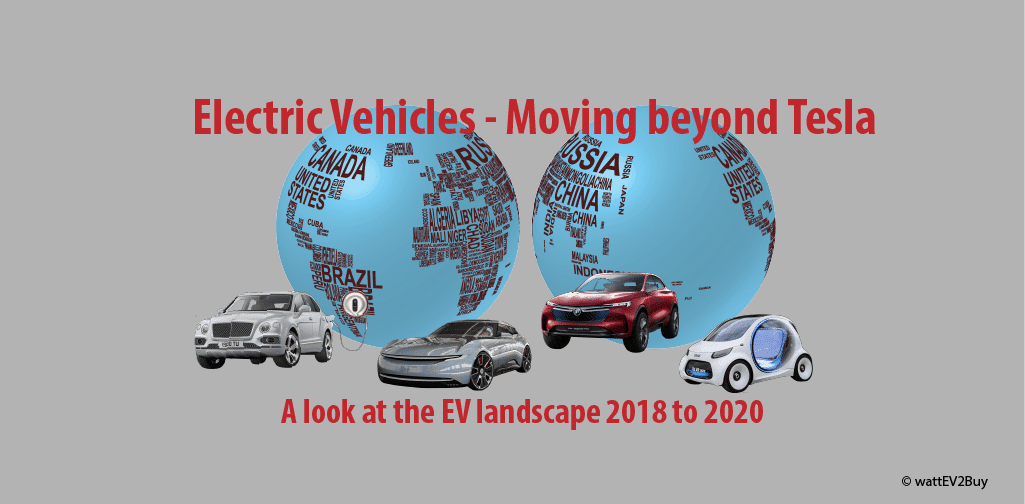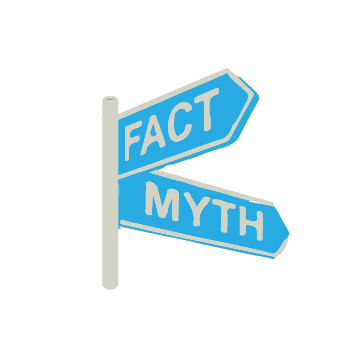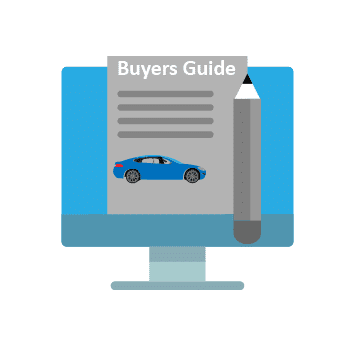THE EV LANDSCAPE 2018 | HOW THE AUTO SECTOR RESPONDS TO TESLA
I have been asked by the organizers of the Africa Utility Week to provide insight into the international EV landscape. Let me start off to say the title does not imply that the presentation is anti-Tesla, so hold your horses if you are short of Tesla stock. The presentation aims to look at how the rest of the market is adapting to the disruption brought on by Tesla shifting the transition to sustainable transport forward by a decade.
For the presentation when referring to electric vehicles, I only refer to pure electric cars (EVs or BEVs), not plug-in hybrid electric vehicles (PHEVs). Buying a PHEV can be compared to a smoker switching to menthol cigarettes thinking he is cutting down. In April the WHO released figures that show by living in a city you are exposed to the same amount of pollutants as a smoker smoking three packets of cigarettes a day, much of which comes from inhaling gasses from combustion vehicles. Plug-in hybrid electric cars make no sense, you buy a luxury vehicle and throw in a fuel tank of a Hyundai i10 to make space for the battery, and get the electric range that is half that of an electric Mahindra Rickshaw. You also pay more to have two technologies and increase your service cost. We know that an EV has a useful life of 500,000 miles and a combustion vehicle only around 100,000 miles. Again, it makes no sense to buy a car with the ability to last you a lifetime and then shortening it and paying more to do so. Plug-in hybrids are just a get out of jail card for auto brands that try and play catch-up with Tesla. Okay, I will get off my soapbox, but I am not the only one. From April this year, the Chinese Government is phasing out incentives for plug-in hybrids with a range below 150km (94 miles) and the British Government is said to ban the sale of PHEVs from 2040. Inevitably when we now talk about EVs we also include autonomous-electric vehicles, thus for the presentation, one will mean the other.
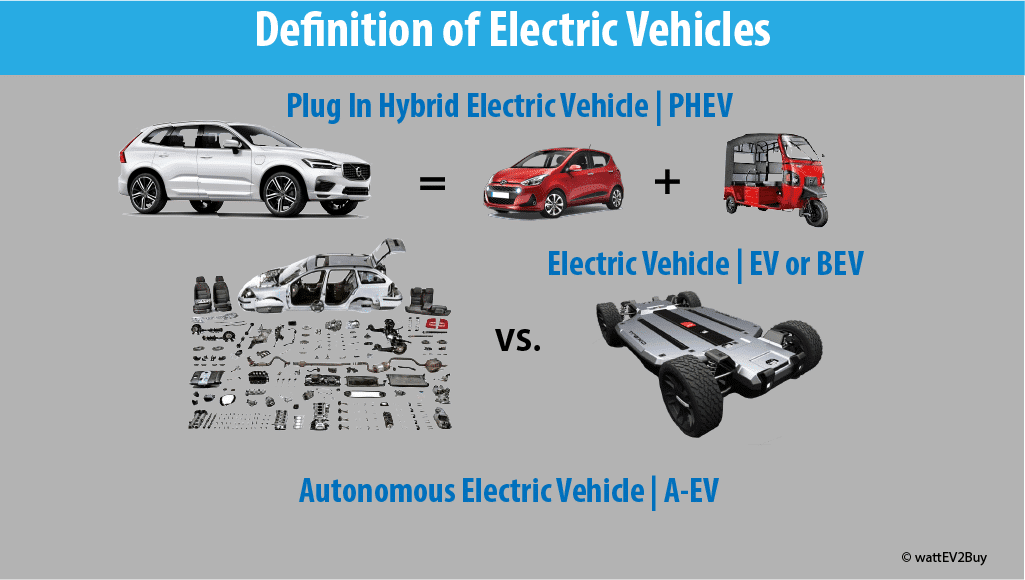
PRICES OF EVs WITH A RANGE OF 200 MILES
At the start of the decade, it would have cost you a pretty penny to buy an EV with a range of over 200 miles. We can see from the picture below that from 2010 when a Tesla Roadster cost $110,000 to the BYD e6 in 2015 the price for a 200-mile car halved. VW will release its I.D. NEO EV in 2020 and have indicated that it would cost between $25k and $30k. It is also expected that the I.D.NEO will have a range of at least 250 miles. It can be assumed that governments will stop with EV subsidies by 2020
Most pundits have been saying that EVs will only be a factor once they reach price parity with internal combustion vehicles (ICE) and that this point will only be achieved somewhere between 2022 and 2025. For the point of argument let’s set the affordable ICE car as a 2018 Volkswagen Golf SE 1.8L TSI with a starting price of $25,000, excluding charges, and a range of 319 miles in the city. Even though VW will price the NEO EV higher than an ICE car, when in fact it is cheaper to manufacture, owning the NEO in 2020 will be cheaper when comparing total cost of ownership. The EV landscape is fast changing and arguments of 2016 does not hold anymore as technology improvements and bigger investments in new EV capacity bring down cost faster than forecasted.
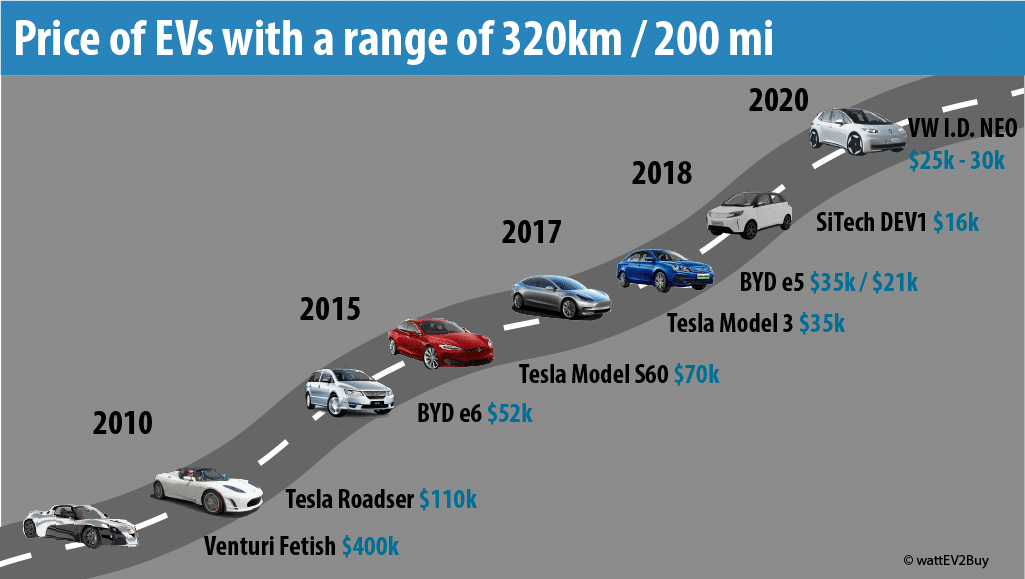
RANGE OF AFFORDABLE NEW EVs SINCE 2010
From 2008 to 2010 most auto manufacturers dabbled with electric cars and had developed an electric propelled prototype or concept car. Industry executives however decided against changing to a new propulsion form for financial reasons and continued to dish up dirty ICE vehicles to the consumer. Between 2010 and 2016 no real improvements were made in range and price. Dieselgate and the Paris climate pact forced the industry to take notice of the progress Tesla made. Porche‘s CEO even admitted last year that Tesla is taking potential clients away from it. The picture below shows the range of new models launched in each year between 2010 and 2020. The threat of the Tesla Model 3, the first mid-size mass produced EV sparked GM to develop the Chevrolet Bolt and release it ahead of the Model 3, they, however, neglected the mass produced bit and kept production at only 30,000 units annually. Most auto brands now have an e-mobility strategy in one form or the other. Some, are making a real effort while others still choose to live with blinkers on. Companies such as VW are investing substantially to shift towards electrifying their fleet. Unfortunately for the consumer, these efforts will only equate in more choice by 2020, making the Model 3 the only available volume solution in the mid-size range. Sure, Hyundai and KIA will also release an updated Ioniq, Kona SUV, and Niro SUV but their production volumes remain limited. Hyundai has a production target of 48,000 units of the Ioniq BEV for 2018 with half earmarked for the local market in Korea. Tesla is to unveil the MODEL Y this year so don’t be surprised if the bar is lifted yet again, offering a better range that targeted by the “new” entrants, being the old guard auto manufacturers.
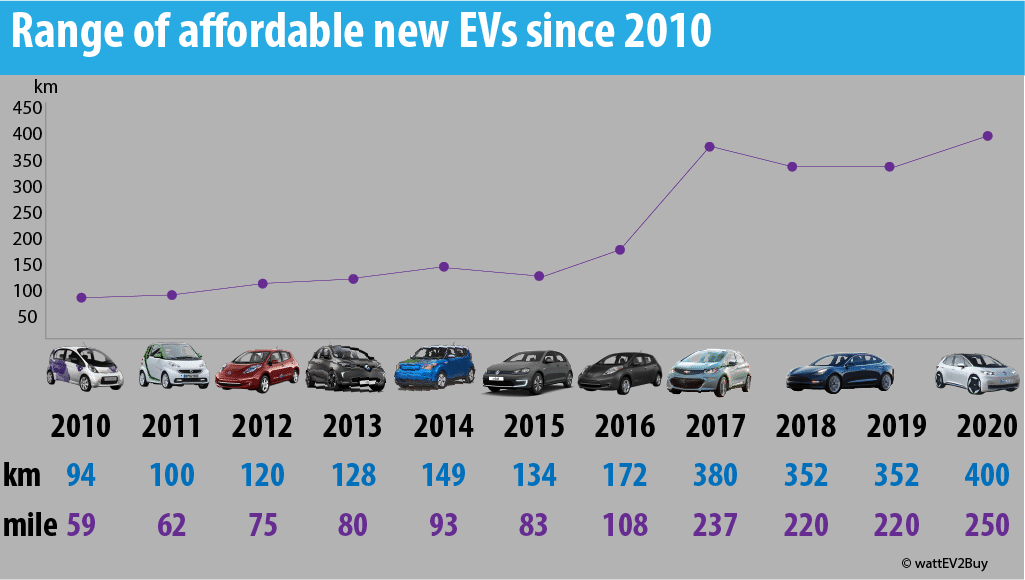
Citroen C-Zero, Smart ED, Nissan Leaf, Renault ZOE, KIA Soul, VW e-Golf, Nissan Leaf 2016, Chevrolet Bolt, Tesla Model 3 and VW ID NEO
EVs BELOW $20,000 IN 2018: ALL MARKETS EXCLUDING CHINA
Disappointingly no EVs are yet available at an outright price below $20,000, which is in stark contrast with the EV market in China. It is strange however that auto manufacturers in the West can’t sell vehicles such as the Renault ZOE and Mitsubishi iMiev with what we now can call antiquated EV technology, below $20,000.
With the exception of the Renault Twizy microcar, the Smart ForTwo ED is the only EV with a price below $20,000 but only after utilizing the $7,500 US government incentive. Although the Smart EVs real-world range is limited to 58mi / 94km, it is available from 2018 with a 22kW onboard charger allowing it to charge in an hour, making it ideal for city use. Unfortunately, if you want to buy the Smart ForTwo ED be prepared for to wait. Some recent buyers reported waiting periods of up to 12 months. There are some electric car options in the $20,000 to $25,000 range (after subsidies), including the Nissan Leaf and Hyundai Ioniq with real-world ranges of 150mi and 124mi respectively.
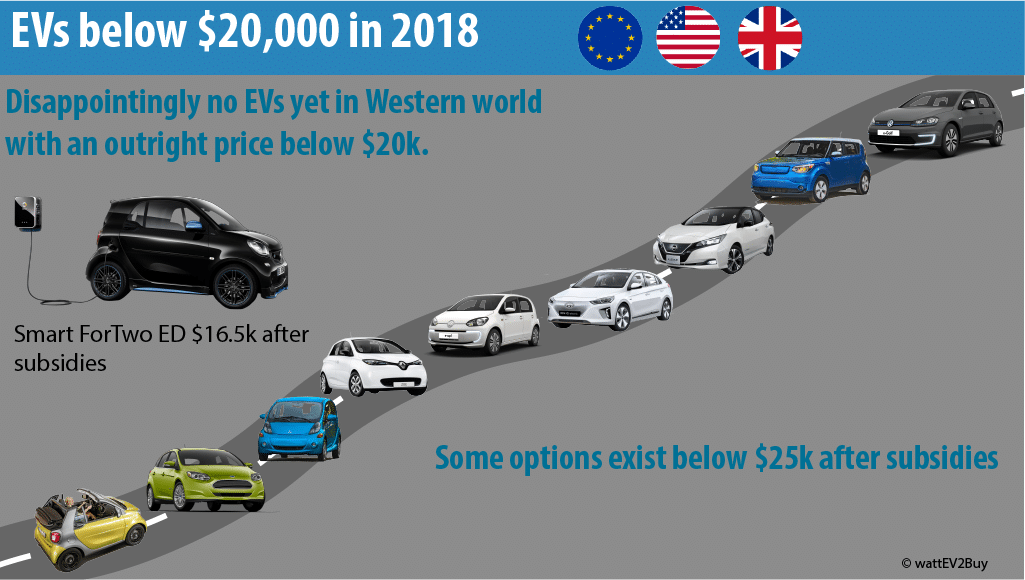
The Smart ForTwo Coupe and Cabriole, Ford Focus, Mitsubishi iMiev, Renault ZOE, VW e-UP!, Hyundai Ioniq, Nissan Leaf, KIA Soul EV, VW e-Golf
EVs BELOW $20,000 IN 2018: CHINESE MARKET
China has the biggest range of EVs available to consumers, with a large selection of electric cars below $20,000. You can now buy the SAIC-GM BAOJUN E100 for as little as $5,000 (after subsidies). In 2018 most of the cars in the A0 class will get range upgrades to around 260km / 160 miles, granted its measured on the NEDC cycle and not real world miles. Be aware, Chinese manufacturers love to quote the range their cars can achieve at a constant speed of 38mph / 60km/h, which will always be significantly more than real-world results. The SiTech DEV1, expected later in 2018 has a range of over 320km / 200 miles and is packed with technology. In April WEIMA introduced the first EV SUV with a price tag below $20,000, the WEIMA EX5. Again, you have to ask yourself why China can produce EVs below $20,000, before government incentives, and not the best automakers in the West? The Chinese Government has embarked on an aggressive EV strategy in its 12th five-year plan from 2011 to 2015, followed by the 13th 5-year plan which targets self-driving. The 12th 5-year plan had a budget of RMB 100 billion ($14.4 Billion) which included the promotion of EVs through subsidies, development of a charging network, and manufacturing incentives. Chinese EV regulations are now moving from a carrot to a stick strategy, where manufacturers are forced through regulation to produce more EVs with better technologies. Chinese EV incentives will run out by 2020. The advantage that the Chinese EV sector is gaining makes it a threat to Western auto brands.
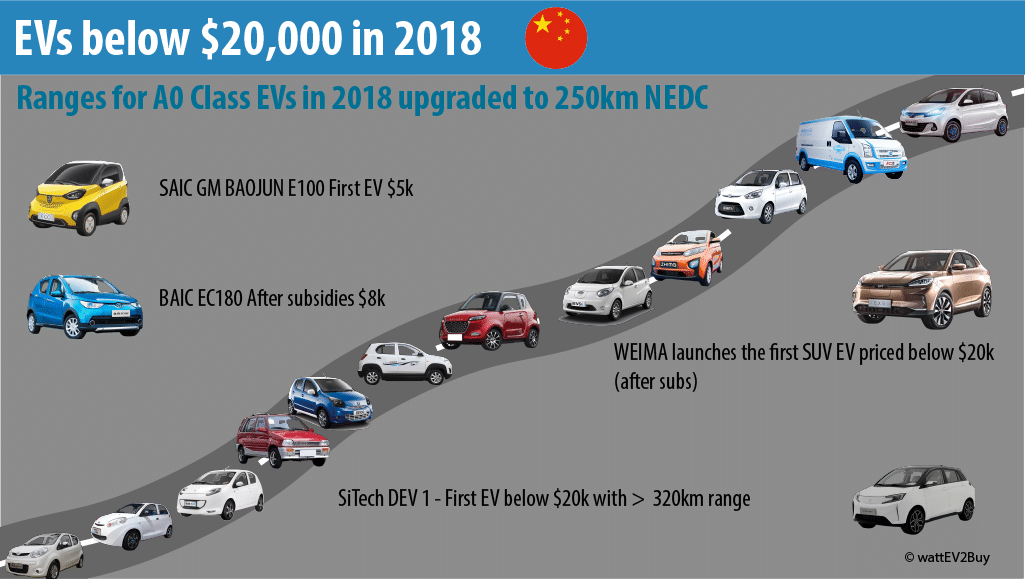
Changan Benni Mini, Hawtai Lusheng EV160, Haima EV160, Zotye TT11, Zotye Cloud 100, Dongfeng SKIO ER30, ZhiDou D3, JAV iEV6e, Zotye ZhiMa E30, Yulon EV, Sokon Ruichi EC35, and Changan Benni.
ECONOMY CLASS SUVs & CROSSOVERS: ALL MARKETS EXCLUDING CHINA
SUVs and Crossovers are the best performing class for most auto brands, proved by Ford‘s shift out of sedan cars to focus its business on developing SUVs, Crossovers and Pick-up Trucks. It is both surprising and telling then why there are so few EV models in the economy SUV class. The South Korean sister companies Hyundai and KIA saw this gap and is launching the Hyundai Kona and KIA Niro EVs this year. Sales will start Korea in the second half of 2018 and slowly move from there into other markets. Hyundai will only produce 18,600 Kona EVs, and 21,000 Niro EVs in 2018 and most are for the local market. The lack of economy class SUVs is telling of how unprepared all automakers were to invest in EV production capacity.
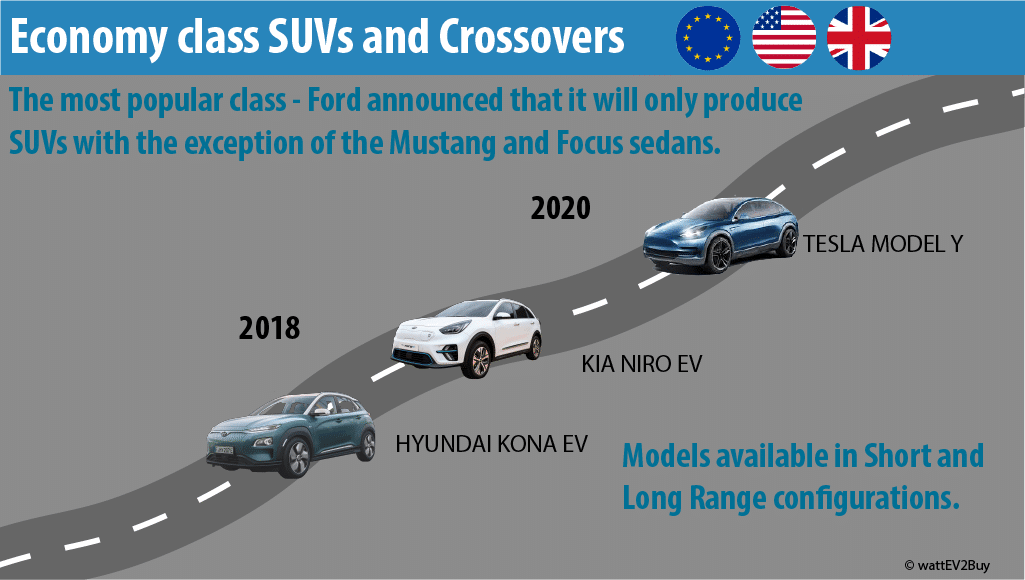
ECONOMY CLASS SUVs & CROSSOVERS: CHINESE MARKET
Again, the picture is completely the opposite in China, where consumers in 2018 are spoiled for choice in the economy SUV class. Start-up EV brand WEIMA launched the EX5 with three range options five days before the 2018 Beijing Auto Show. By the time the show got underway, WEIMA had already over 5,000 pre-orders. WEIMA shocked the market by setting the price for WEIMA EX5 300 below $20,000 after subsidies. Not only does the Chinese car buyer have a wide selection of SUVs to choose from, many of them are packed with great technology. The Marvel X build on the Roewe connected car line-up first introduced in the RX5 SUV and co-developed with Alibaba. The SAIC Roewe Marvel X is the first mass-produced car equipped with AR (augmented reality) technology while the Xpeng G3 has a 360° roof-mounted camera, allowing the driver to stream video of its surroundings to friends on the net. The EV start-up Xpeng unveiled the G3 at the 2018 CES in Las Vegas.
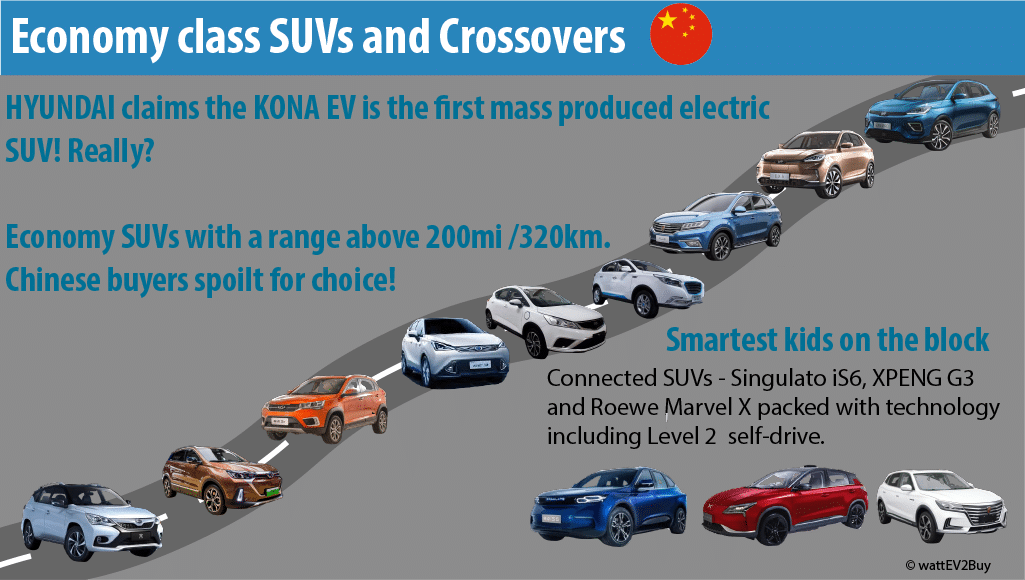
BYD Song, BAIC EX5, CHERY TIGGO eX3, GAC TRUMPCHI GE3, GEELY EMGRAND CROSS, HAWTAI EX380, SAIC ROEWE ERX5, WEIMA EX5, WEIMA EX5PRO, SINGULATO iS6, XPENG G3, SAIC ROEWE MARVEL X
LUXURY CLASS SUVs & CROSSOVERS: ALL MARKETS EXCLUDING CHINA
As expected it is in the luxury SUV class with the highest profit margins that we find the old guard’s strongest response to Tesla. Volvo already announced that it would only produce electrified vehicles in the future. According to Volvo European regulation will potentially add as much as $340 per engine from 2020, diesel engines would therefore just be too expensive to produce. Mercedes also announced that targets by the EU capping the amount of emissions on a brands fleet would cause a lot of pain. In 2016 Daimler for the first time since 2007 failed to cut its emissions, citing the popularity of SUVs as the reason. Europe has set a very stringent target of 95gm CO2/km by 2020. Daimler’s target for 2020 is 100gm CO2. Daimler is one of the automakers that has an above average e-mobility strategy which it accelerated from 2025 to 2022. Waymo recently placed a $2 billion order for 20,000 of the just-released Jaguar i-PACE SUV EVs for its autonomous taxi fleet. Waymo is shifting towards electrified cars for its proposed autonomous taxi fleet because EVs offer a lifespan five times longer than ICE cars. Interestingly enough most Chinese luxury SUV brands are also planning to bring their models to the West. SF Motors and Faraday Future has plans for production in the USA while all of them have research offices in the US or Europe.
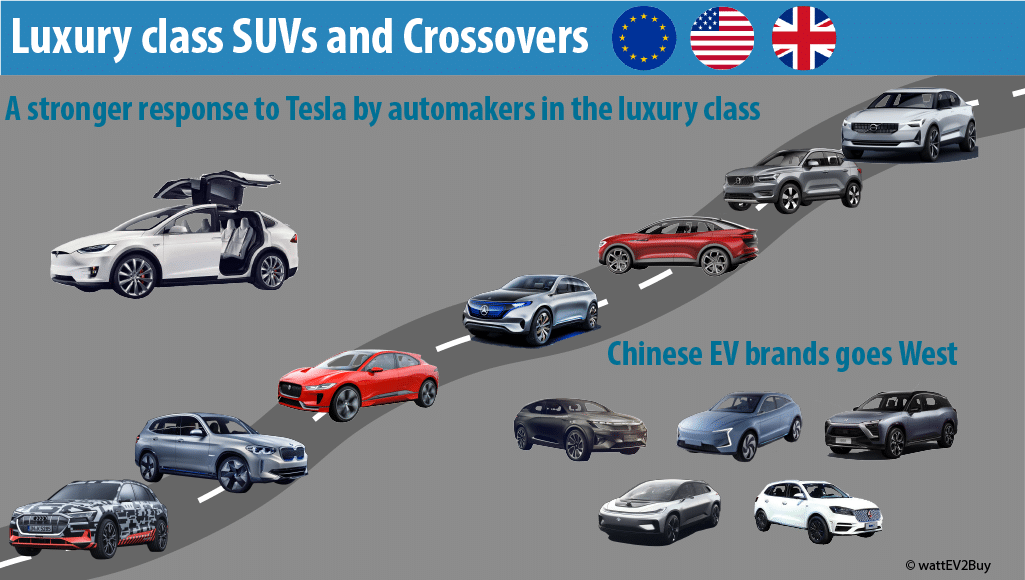
AUDI QUATTRO e-TRON, BMW iX3, JAGUAR i-PACE, MERCEDES EQC, VW I.D. CROZZ, VOLVO XC40, VOLVO 40.2
LUXURY CLASS SUVs & CROSSOVERS: CHINESE MARKET
The list of luxury SUVs coming to the Chinese market in 2018/ 2019 fully comprises of cars developed by EV start-ups, none by traditional auto manufacturers. Most of the start-ups are also backed by the large tech companies in China which are investing heavily in autonomous technology. The NIO ES8 will be released this year, and apart from having removal batteries and access to mobile charging vans the car is packed to the brim with tech. NIO, a NEXTEV company, part-owned by Tencent has developed the NOMI system.
NOMI interacts with people sitting in the vehicle, and its emotion engine gives users a friend on the road. NOMI combines the ES8’s intelligence and car connectivity functionalities to turn the ES8 into a fun, expressive, and intuitive companion that can listen, talk and help drivers along the way.
NIO also launched NIO Pilot, its comprehensive advanced driver assistance system. NIO PILOT is enabled by 23 sensors, including a trifocal front-facing camera, four surround exterior cameras, five millimeter-wave radars, 12 ultrasonic sensors and a driver monitor camera. The ES8 is the world’s first vehicle to come equipped with the Mobileye EyeQ4, which has a computation capacity nine-times more powerful than its predecessors. NIO PILOT’s software and hardware suite enable subscribers to enjoy upgraded services through FOTA updates.
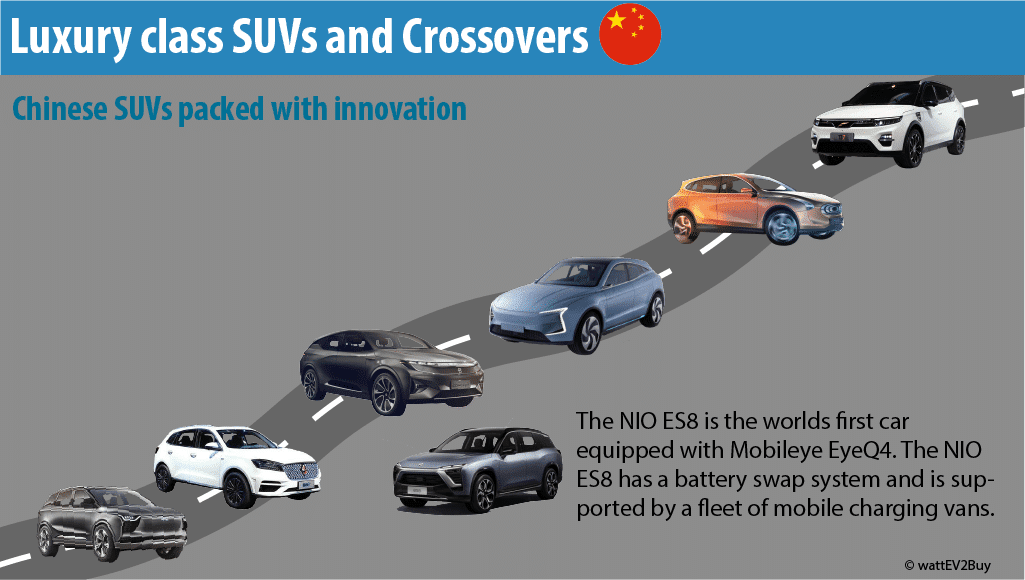
AIWAYS U5-ION, BORGWARD BXi7, BYTON, SF MOTORS SF5, THUNDERPOWER SUV, YUDO Pi7
CREATING NEW COMPETITORS
New EV start-ups are attracting large investments, allowing them to build dedicated EV manufacturing plants. At some point, the Chinese Government tried to restrict the number of EV start-ups out of a fear of overheating the sector. Not all start-ups plan to build 100,000 capacity production plants, some such as Rimac and Elextra only produces limited runs of supercars. In the West, most EV start-ups were created targeting some niche market. The US-based Bollinger is building Sports Utility Vehicles, while Workhorse has partnered with UPS to build electrified delivery vehicles. Thor competes with the Tesla Semi in the electrified truck space. Sono Motors is developing an EV equipped with solar panels for charging. There are also some Chinese backed EV start-ups in the West such as NEVS which is the old SAAB, SF Motors, Karma and Lucid. Some brands such as EQ and Polestar is EV specific brands created by Daimler and Volvo, which will cannibalize their existing brands. The most peculiar entrant on the list is Dyson, the maker of vacuum cleaners, which is proof yet again that it’s not rocket science to build an EV as its far less intensive than combustion engines. Dyson is capitalizing on its mass-production expertise in the home appliance sector to mass produce EVs from 2020. I added Waymo to the list, and although it does not manufacture vehicles, it plays an important role in A-EVs and e-mobility as a service, towards which many manufacturers are pivoting.
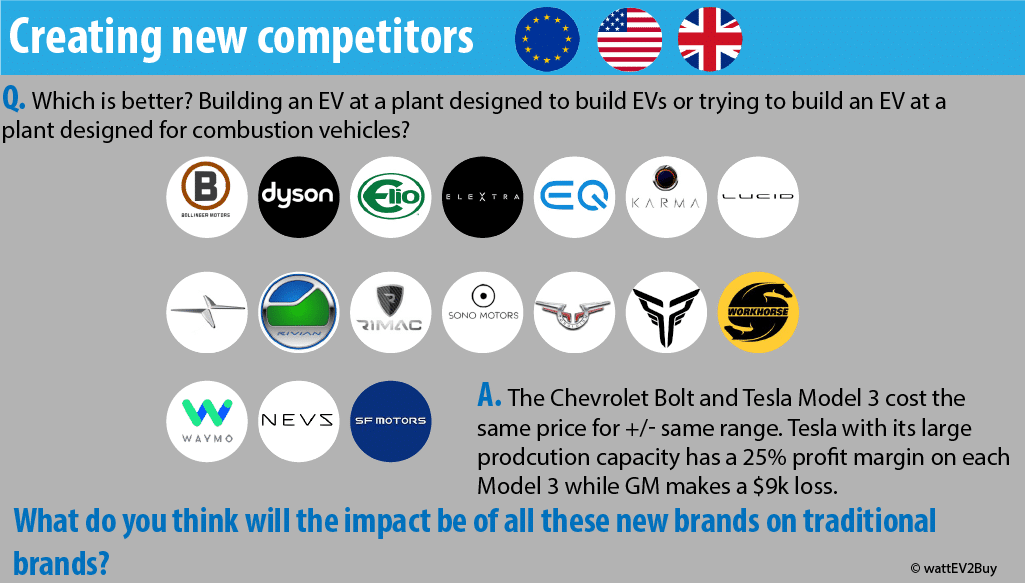
BOLLINGER, DYSON, ELIO, ELEXTRA CARS, EQ, KARMA, LUCID, POLESTAR, RIVIAN AUTO, RIMAC, SONO MOTORS, TOROIDION, THOR, WORKHORSE, WAYMO, NEVS, SF MOTORS
THE CHINESE EV LANDSCAPE
The list of EV start-ups in China is not exhaustive, a company such as Youxia, which is fashioned on the Knight Riders KITT, is not on it. The number of EV start-ups in China makes one wonder if the Chinese Government was successful in curbing the activity in the market. Tech companies are dominating the Chinese A-EV landscape while some traditional auto manufacturers such as BIAC are announcing that it will only produce electrified models in the future. Other than in the West where EV start-ups are focused on niche opportunities their counterparts in China directly target traditional auto manufacturers. Some commentators believe that EVs would trigger a long-awaited industry shake-up forcing mergers with stronger brands or liquidation of loss-making brands which have been propped up by easy loans, government incentives, and regulations to develop a local auto sector.
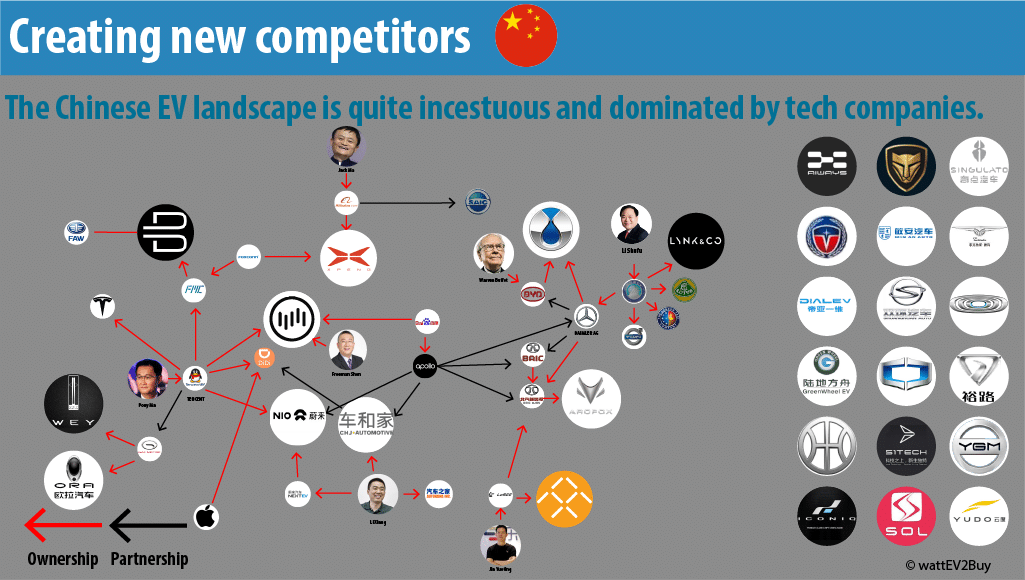
GWM ORA, GWM WEY, BYTON, WEIMA, NIO, CHJ AUTO, XPENG, DENZA, ARCFOX, FARADAY FUTURE, LYNK&Co, AIWAYS, AOXIN, DIAL EV, GREENWHEEL, HYBRID KINETIC, ICONIQ, LVCHI, MI’NAN, SHUANGHUAN, SINOGOLD, SiTECH, SOL, SINGULATO, TECHRULES, THUNDERPOWER, YULON, YGM, YUDO
EV SALES – TOP 10 EV COUNTRIES 2017
EV sales in 2017 cemented to shift to EVs. While sales are not huge it still comprises over 2% of the total fleet of passenger vehicles in the USA and China. The composition of EVs in Norway now stands at over 50% of annual car sales. Stand-out points from 2017 EV sales is the Chinese EV sectors dominance, sparked by government support and secondly, how car buyers in certain countries such as Germany and Canada are shifting towards EVs. One must remember that although these figures don’t look significantly high on the face of it, it is happening in an environment where there are constraints such as a lack of supply, high prices for EVs and no big marketing budgets fueling demand. In fact, there is a general lack of knowledge by the majority of consumers about EVs. Many studies have highlighted the inability and unwillingness of traditional motor dealerships to promote electric vehicles. The Sierra Club’s Rev Up EVs report on the consumers EV purchase experience identified that traditional dealers, especially outside of California are not promoting the technology. One of the key findings was that automakers still provided higher commission structures for gas guzzlers.
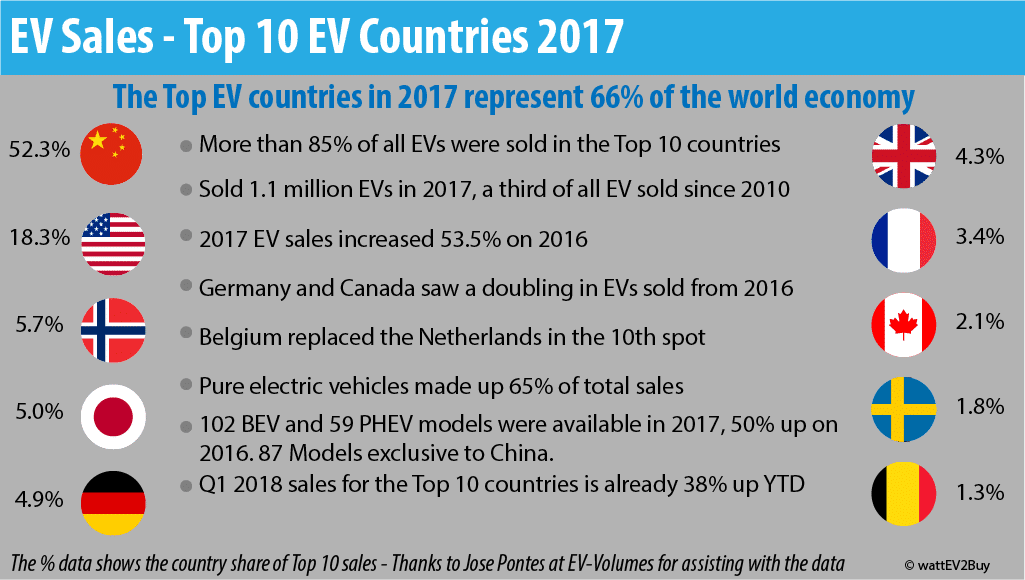
TOP SELLING EV MODELS
The ranking below is for pure electric vehicles only. Interestingly enough should we include PHEVs in the ranking they will only account for 26% of the total top 10 EV sales. The ten models in top EVs contribute over 50% of all EV sales in 2017 from 102 models available to the consumer. Tesla’s dominance in the EV market is clear when ranking the top 10 EVs and its closest competitor in the US, GM, performance is capped at its production capacity. Technically the BMW i3 should not be placed in the tenth position in 2018 as the sales represent the total for the BMW i3 and BMW i3REx which has a fuel based generator. The first three months of the year is historically the worst months for EV sales, yet sales for Q1 2018 is already 38% up on 2017.
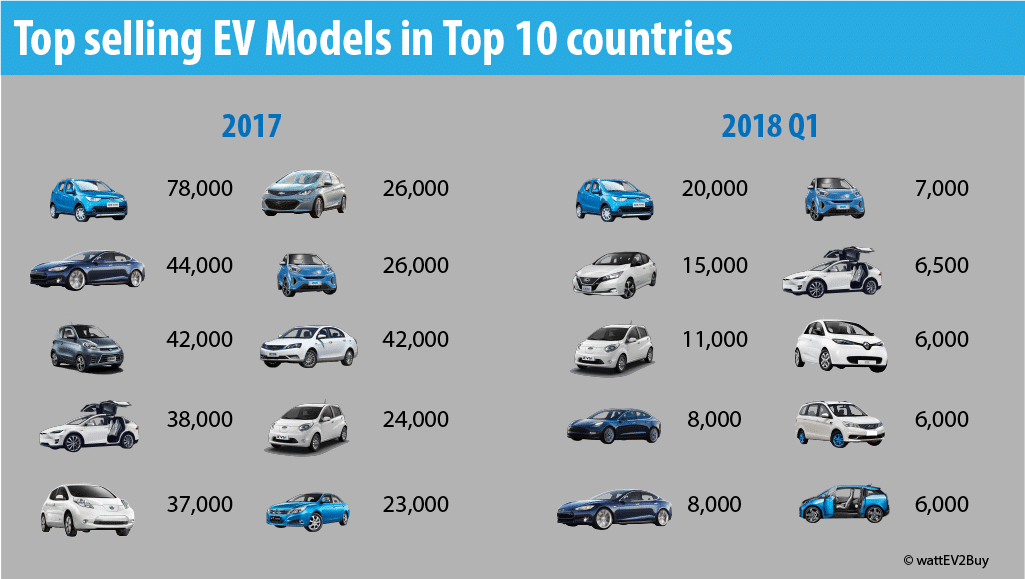
2017 – BAIC EC180, TESLA MODELS, ZHIDOU D2, TESLA MODEL X, NISSAN LEAF, CHEVROLET BOLT, CHERY eQ1, GEELY EMGRAND, JAC iEV6e, BYD e5 | 2018 Q1 – BAIC EC180, NISSAN LEAF, JAC iEV6e, TESLA MODEL 3, TESLA MODEL 6, CHERY eQ1, TESLA MODEL X, RENAULT ZOE, KARRY K50, BMW i3
TOP SELLING EV BRANDS
BAIC and Tesla are the best performing EV brands over the last 15 months, each having sold 124,000 units over the period. BAICs lead is dependent though on the performance of the BAIC EC180 which sold 98,000 units compared to Tesla’s models contributing nearly equally to its success.
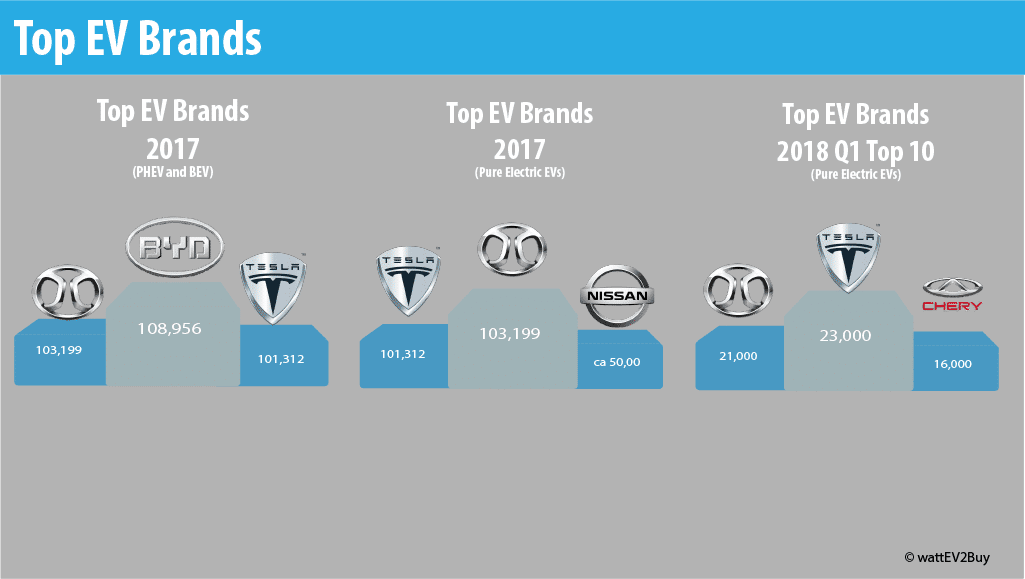
EVs SALES TO SURPRISE ON THE UPSIDE
I can only expect EV sales to surprise to the upside as we get closer to 2020 and beyond. Some of the most optimistic forecasts only see EV sales to reach 6 million units by 2024, while battery capacity in 2020 will be sufficient to power 6.5 million vehicles, assuming an average battery pack of 50kWh. Sure, the batteries are also used for buses and trucks which use much larger packs, but the bulk of passenger cars sold is from the A0 class which uses battery packs of around 30kWh, and don’t forget the PHEVs which use 12kWh at best. My exposure to EVs puts me in contact with buyers and potential buyers of EVs on a daily basis, from which my subjective experience is that the nature of EV buyer has shifted from the fanatical to the average car buyer over the last 18 months.
According to a survey by the German publication “Automobilwoche”, the success of electric cars in Germany seems to be the technologies biggest risk as prospective buyers now face delivery times that can have them waiting as long as a year for their new EV. The problem is not isolated to buyers of imported vehicles only but also local brands such as Volkswagen where buyers have to wait until October 2018 for delivery of e new e-Golf purchased today. Smart CEO Annette Winkler said that the increase in demand is much stronger and faster than could have expected and planned for with the companies suppliers, resulting in buyers only receiving their new Smart by the end of 2018 or early 2019.
To compensate for the increased demand, Volkswagen has introduced a second shift at its Dresden plant as e-up! buyers wait for five to six months. According to the survey, the waiting period for a Hyundai Ioniq EV is up to 12 months, the 2018 Nissan Leaf is around ten months, and six to seven months for the Peugeot ION and Kia Soul EV. Renault Zoe buyers only have to wait four months while the waiting list for a BMW i3 is the shortest at two to three months. The problem is not isolated to private buyers, but fleet buyers are also affected. The software giant SAP wants to be carbon neutral in 2025 and is currently expanding its e-fleet. SAP manager Marcus Wagner told “Automobilwoche”: “If you want to buy a full electric in February 2018, you will get almost none.” It seems to me the problem is not isolated to buyers who placed pre-orders for new EVs like the Tesla Model 3.
The Chinese Government is to implement a pilot program on the resort island of Hainan and use the island as a test case by being the first to ban the sale of fossil-fuel vehicles.
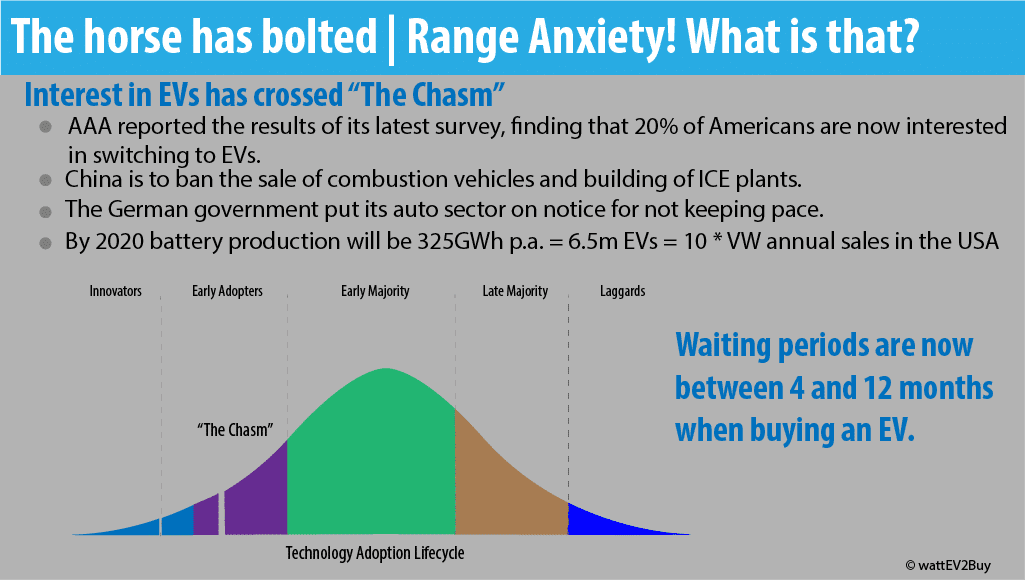
WHAT DOES SHIFT TO A-EVs MEAN FOR EMERGING MARKETS?
In my opinion, EVs represent progress, and if you don’t have an EV strategy, you will not progress. Your economy will fall behind the rest of the world, you will lose skilled people and your economy will suffer from the strains associated with pollution caused by ICE vehicles and importing of energy. Unfortunately, the cost of preparing for EVs and A-EV is very high and most emerging economies grapple with a host of challenging social issues which will only get bigger as the rest of the world moves forward leaving them behind. Unfortunately, ignorance is bliss and governments of some developing states are not even aware that EVs are a factor to consider. I am going to use the City of Cape Town as an example of the lack of unpreparedness. The city is known as the ‘greenest’ city on the African continent, but there is only one charging station at the Waterfront, not including three at dealerships. The city does not even support small businesses that offer electric bicycles to tourists. These companies have to install their own infrastructure throughout the city. Sorry, I am on my soapbox again. In all seriousness, I do see that the shift to EVs is going to be faster than anticipated and as we have seen so far will even catch traditional automakers by surprise causing them to dump ICE vehicles on the developing world. Dumping has already started, smart from 2017 is only selling EVs in the USA and from 2020 will do the same in Europe, leaving them to effectively dump their ICE capacity on the rest of the market.
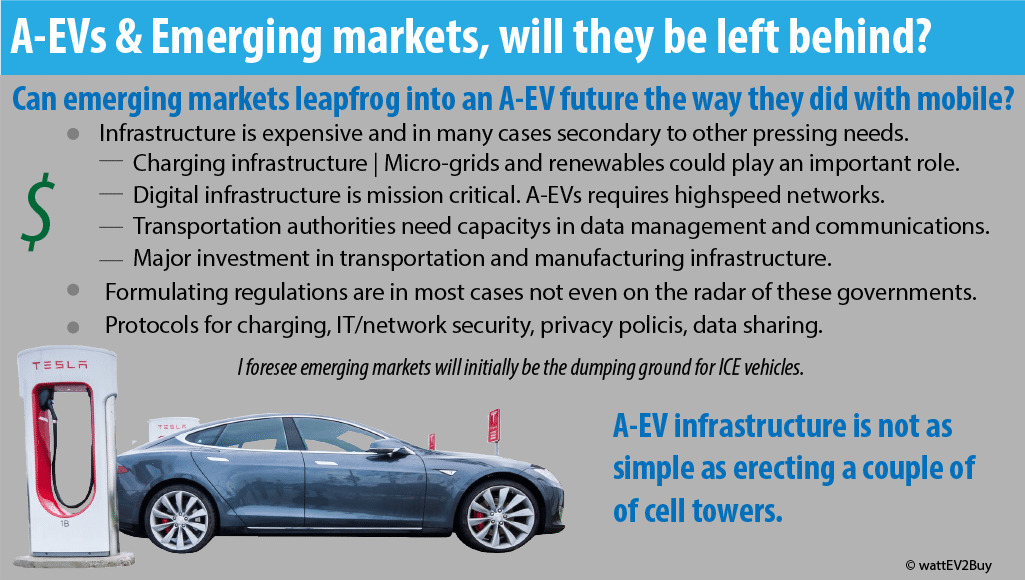
HOW WILL SHIFT TO A-EVs IMPACT SMART CITIES?
A-EVs will truly transform cities into smart cities. One should also not forget that EVs does not merely mean passenger cars but all types of transport that can be electrified, from delivery vehicles to buses and even bicycles. Traditionally city planners can only count on bicycles as a transport solution for commuters in a ten kilometer (6 miles) radius from their homes. With the availability of electric bicycles, it’s application can be extended for longer daily commutes. The following sentence has represented my view on electric vehicles from the first time that I had the pleasure of driving one.
“At wattEV2Buy we live for a future where the Electric Vehicle rule and rush hour noise would be the sound of happy people talking and birds singing.”
– To prove our point, listen to the birds on the launch video of the Aston Martin RapidE
Back to reality. I don’t think anyone can do justice to the topic of the disruption we are about to experience the way Tony Seba does. I, therefore, implore you to watch his recent presentation on Clean Disruption of Energy and Transportation. Tony brings the relevance of A-EVs to city planners together in the last 10 minutes, but the first 60 will not leave you bored at all.
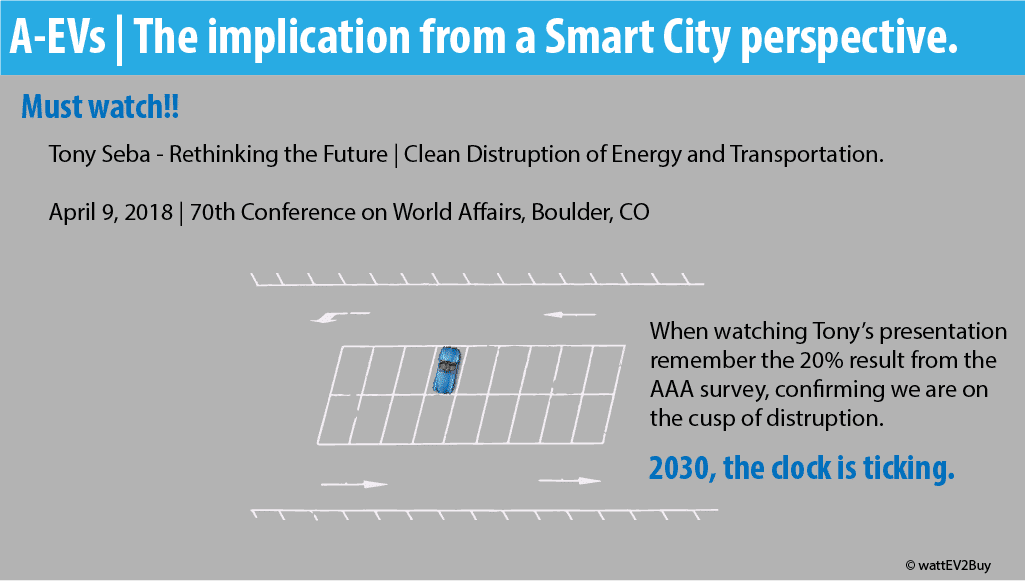
In conclusion, it is clear that the world is on the cusp of a major disruption in the transport sector. This presentation did not even address the electrification of the commercial vehicle market or public transport. Not a day goes by that you don’t read of a company announcing bus orders by cities all over the world. We are certainly in for some exciting times. One thing is for certain; the auto sector will not be the same ten years from now where consumers will be the real winners for which we only have Tesla to thank.
CHINESE EV DATABASE AVAILABLE IN OUR SHOP
No Results Found
The page you requested could not be found. Try refining your search, or use the navigation above to locate the post.

